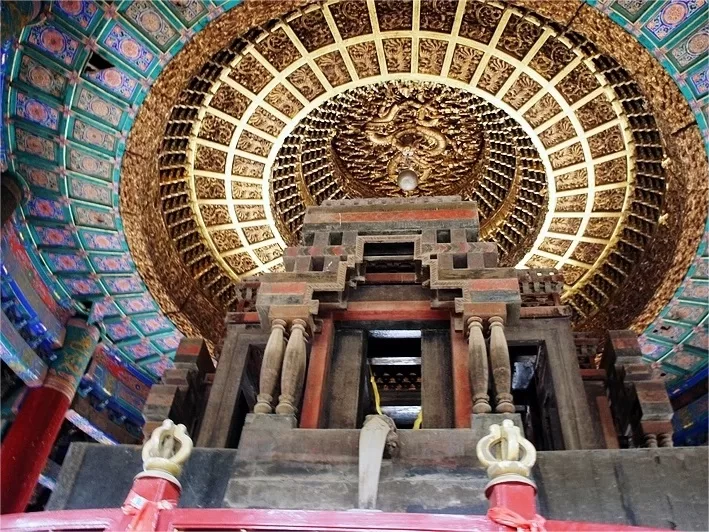Pule Temple (普乐寺), also known as “Yuantingzi (圆亭子, Round Pavilion),” is situated in the northeast of Chengde City in Hebei Province, China. It was constructed during the Qing Dynasty, specifically in the 31st year of the Qianlong Emperor’s reign (1766), to honor and accommodate the newly affiliated tribes, including the Durbert, Left and Right Khalkha Mongols, and East and West Buryats, who joined the Qing Empire. The name “Pule” is derived from the famous line in Fan Zhongyan‘s “Yueyang Tower,” which expresses the idea of sharing joys and sorrows with the world.
Covering an area of 24,000 square meters, Pule Temple faces west. The architectural style is a combination of Han and Tibetan influences. The western part follows the style of Han Chinese temples, comprising a mountain gate, Hall of Heavenly Kings, Bell and Drum Tower, side halls, and the main hall. The eastern part features Tibetan-style buildings. The central structure, known as Xuguang Pavilion (旭光阁), is the highlight of the temple with its unique design, resembling the the Hall of Prayer for Good Harvest in the Temple of Heaven.
Table of Contents
- Basic Information
- Location and Transportation
- Highlights of Pule Temple
- Video about Pule Temple
- Useful Tips Summarized from Reviews
- Attractions near Pule Temple
Basic Information
| Estimated Length of Tour | 1 – 2 hours |
| Ticket Price | 30 RMB (1st May – 9th October) 20 RMB (10th October – 30th April the next year) |
| Opening Hours | 8.30 – 17.00; Last admission: 16.10 (1st January – 30th April) 8.00 – 18.00; Last admission: 17.10 (1st May – 9th October) 8.30 – 16.30; Last admission: 16.00 (10th October – 31st December) |
| Area | 24,000 square meters |
| Telephone Number | 0086-0314-2057557 |
Location and Transportation
Pule Temple is located opposite to the Chengde Mountain Resort in the picturesque city of Chengde, which is located in the northeastern part of Hebei Province, China.
Visitors can take bus 10, 26, Tourist Line 2, or Tourist line 5, get off at Lama Temple Stop (喇嘛寺站), and walk about 700 meters to the east to get there.
Highlights of Pule Temple
Xuguan Pavilion

Xuguang Pavilion stands in the rear half of the Pule Temple and rises 23 meters high with a diameter of 21.68 meters. The central circular stone base within Xuguang Pavilion holds the largest existing wooden mandala in China, composed of 37 wooden pieces symbolizing the thirty-seven factors of enlightenment. Inside the mandala is a bronze statue of Shengle Wang Buddha, also known as the “Joyful Buddha” or “Happy Buddha,” a variant of Avalokiteshvara Bodhisattva. Legend has it that Avalokiteshvara Bodhisattva practiced facing east on Mount Potalaka, inspiring the eastward orientation of this Buddha.
Zongyin Hall

Zongyin Hall is a seven-bay, five-deep hall with a roof covered in glazed tiles. Colorful glazed ornaments decorate the roof ridges, with several yellow glazed dragons running through the middle. In the center, a glazed Lama stupa is embedded. The walls on both sides depict auspicious symbols like umbrellas, golden fish, treasure vases, lotus flowers, conch shells, dharma wheels, dharma banners, and Bazha, i.e. the Eight Auspicious Symbols. The main altar in the hall features the Buddhas of Infinite Life, Shakyamuni, and the Lamp-lighting Buddha, with a relief of the golden-winged Garuda above them. The side walls display the Eight Great Disciples.
Side Halls of Zongyin Hall

The Zongyin Hall is accompanied by two side halls, each five bays wide. The right hall is called Huili Hall (慧力殿) and houses three-headed, six-armed Mahakala and a four-armed Wrathful Demon King, both adorned with 50 human heads representing Sanskrit’s 16 consonants and 34 vowels. The left hall, known as Shengyin Hall (胜因殿), enshrines secret accomplishment Vajras, both outer and inner Vajrapanis, all manifestations of Maitreya.
Shacheng (阇城)

The temple also features Shacheng (阇城), also known as Jingtan or Tan Cheng, a three-tiered structure. The first two layers are square stone platforms, with the first layer having a three-door hall and 72 surrounding corridors. The second layer has decorative ridges and four doors, with eight stupas positioned at the corners and midpoints of each side. The third layer is adorned with cloud dragon patterns on its stone railings.
Video about Pule Temple
Useful Tips Summarized from Reviews
Scenic Path to Qingchui Peak: Take the secluded path on the right side of the temple’s main entrance to reach Qingchui Peak. This path offers a peaceful journey with panoramic views of Puning Temple’s surroundings.
Parking Information: There is a parking lot at the entrance. The fee is 5 yuan per hour for small cars and 50 yuan for the whole day.
Quiet Atmosphere: Pule Temple is not a popular tourist spot, making it quiet and serene. Enjoy the tranquility as it is not frequented by large tourist groups.






